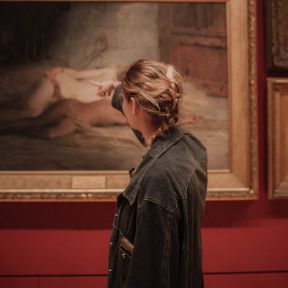CREATIVITY- To Copy? To Imitate? To Learn Through Mimetics When time runs short and creativity wanes, look to the masters for inspiration.

KEY POINTS-
- When inspiration runs low, take motivation from the masters in your genre.
- Imitation teaches the student how to see with clarity.
- Mimicry informs craft, but the next step must be morph the process and product to become novel and fresh.
- Mozart was inspired by Handel and Bach. Billy Joel was inspired by Debussy, Brubeck, and The Beatles.
It's 8:04 p.m.
I'm running out of time.
Every week, I finish writing, editing, and posting an essay about creativity, motivation, and art-making.
But time ticks away.
I need to get mom to bed soon.
She's sitting beside me, already dressed for bed. The oxygen machine pumps away, feeding her concentrated air through a plastic tube looped over her ears and two prongs inserted into her nostrils. She asks, "Do I breathe through my nose?"

"Yes," I say. "That's the best way to get the oxygen."
I’m torn between my caregiving duties and a self-imposed obligation to maintain my routine.
I need inspiration, and I need it fast.
For some reason, I think back to an assignment from a long ago creative writing class. Our instructor told us to find a passage from an author we admired and write in their style.
The word mimetics rises from the deep crevices of my cerebral cortex, and I imagine that classroom where I sat across from Jack, my writing buddy. But then, my brain resurrects a memory of a visit to the Museum of Fine Arts in Boston. Students perched on benches, sketch pads on laps, pencils in hand. Each student focused on a masterpiece on the wall in front of them. The students looked and drew and looked again. Monets, Sargents, Bensons. These pupils of painting modeled the masters with precise detail.
This process of imitation and mimicry infuses the art student with an imprint that becomes a foundation for their own art later.
Just as children master letter-making by tracing dashed letters on paper, just as repetition of the times tables provokes the automatic knowing of What Is 4 Tmes 5, determined modeling for any art student supports their own production of art.
A fiber artist first follows a pattern or instructions from a book on YouTube.
A carpenter works as an apprentice.
A chef begins on forks, then graduates to a sous chef, and later assumes the role of chef de cuisine.
Creativity feels unattainable to some, but imitating others makes each process achievable.
Through repetition and production, art products of distant lands and long ago times inform the present day. “In that sense, those stigmata could be considered a secondhand imitation—the imitation of the painting rather than the imitation of Christ himself, whom they (those with stigmata) have never seen” (Oughourlian, 2016, page 90).
In a time of technology and immediacy, creatives suffer the constant diversions that call from the palm of their hands, their phones. "Did you see so-and-so's recent post?" "Are you following Blank's Tweets?" "Remember to share your smiles and outings on your Socials."
Remember to look up, too.
In a recent post on Instagram, blogger, creative consultant, and former Disney Imagineer Joe Rohde wrote, “Even performative exoticism, like a tourist dance show in Bali, or a theme park simulacrum, will still awaken the senses if you've never seen one before. Any work of art that is sufficiently unfamiliar will do so as well” (2023, September 27).
To stay sharp and alert, challenge yourself to go outside, travel, and experience new things.
As Hamlet said, “The play’s the thing.” Or is it? Does it matter?
Animal Kingdom's The Tree of Life exists nowhere, but the creation invites me, the theme park visitor, to rethink my family tree, the oak and maples in my yard. Disney’s pretend tree is more memorable than the more than 4 million living plants.
We all have heroes or models working in our chosen art form.
Look at one of their art products and dissect it into parts.
Use the rule of 3s to interpret any art product.
For example, in visual art, you can analyze a painting in terms of shape, line, and arrangement. For literary art, you can explore the story in terms of character, plot, and setting. You can analyze an entree by regarding taste, texture, and plating for culinary art.
You get the idea.
Do this exercise quickly, research your art hero, and then search for their work.
Now, how will you imitate their work?
Can you copy the painting?
Can you adapt the work to make it your own?
Can you imagine that the artist is coaching you?
Some products are too large and complex to copy in 15 or 20 minutes, but that's the point.
You're not recreating the Sistine Chapel. Or War and Peace. Or Holst's The Planets.
You're quickly sketching out how to copy and learn from the master.
One of my favorite artists is Mary Cassatt. Her portraits of women and children evoke a strong sense of love, protection, and joy. Her lines are quick and straightforward. The shapes are simple, often impressionistic. The compositions are intense, with the figures filling the canvas.
If I copy her work, I will start with a photo of a mother and her child. I'd likely pull out an old family photo of me and my kids. Then, I'd consider the medium. It's probably digital because it's inexpensive, easily corrected, and simple to have printed if it turns out good.
Mimetics works for any art form:
- Literary: Hemingway, King, Collins
- Visual: Kahlo, Picasso, Rembrandt
- Fiber: Archaintre, Just, Hill
- Environmental: Hammond, Myers, Mendez
- Performing: Swift, Boccelli, Dylan
- Industrial: Mackintosh, Wright, Eames
- Culinary: Child, Beard, Hollywood
Take a deep dive or skim the surface and stay shallow.
Have fun and see what you can learn from the masters in your art form.
Even models of models, recreations, and imitations, even those imposters, help me see my small world with new eyes.
- Questions and Answers
- Opinion
- Story/Motivational/Inspiring
- Technology
- Art
- Causes
- Crafts
- Dance
- Drinks
- Film/Movie
- Fitness
- Food
- Juegos
- Gardening
- Health
- Home
- Literature
- Music
- Networking
- Other
- Party
- Religion
- Shopping
- Sports
- Theater
- Wellness
- News
- Culture
- War machines and policy

